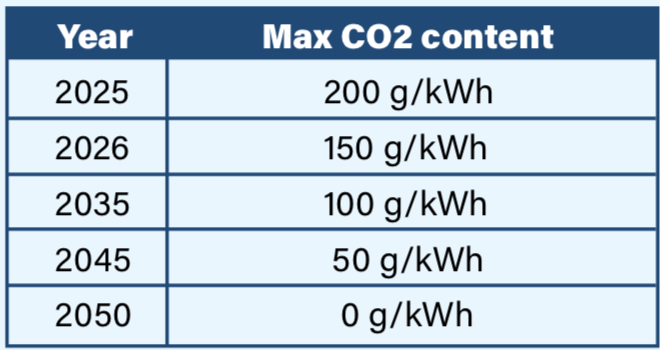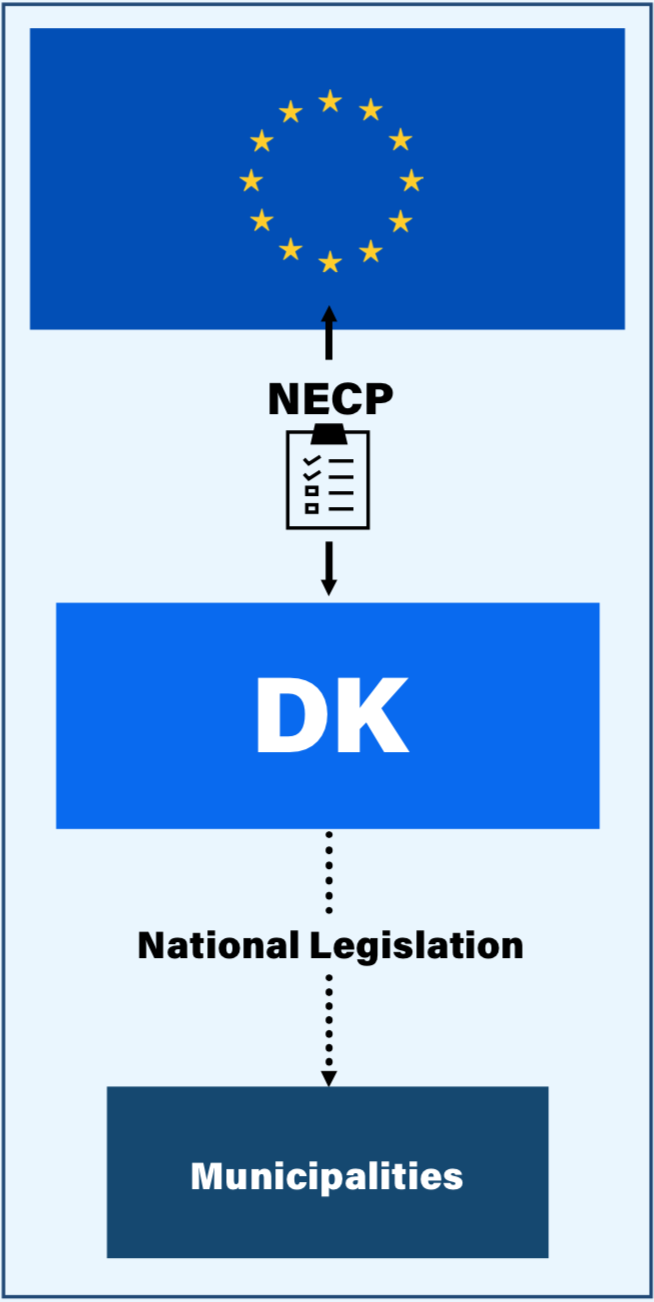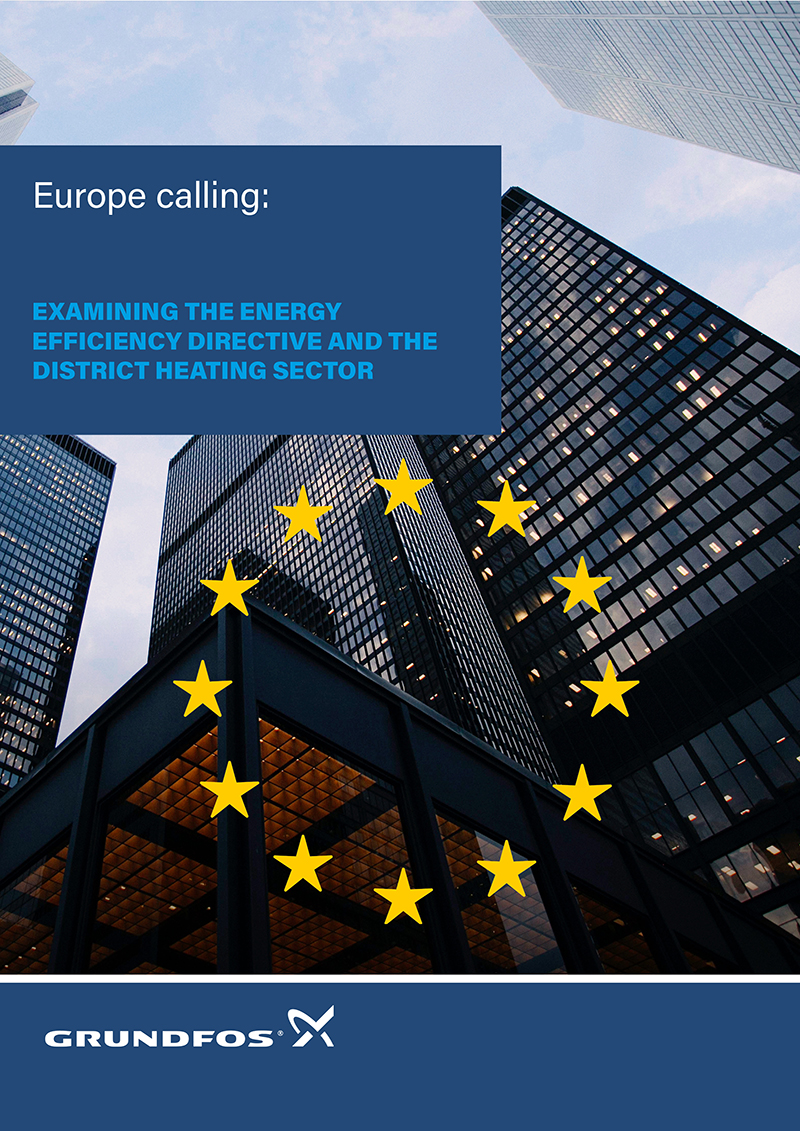The EU has recast the energy efficiency directive. As politics plays a crucial role in the development of future district heating markets, stakeholders within the sector should pay notice
The new energy efficiency directive integrates a larger push for 4th generation district heating and a better governance, which will influence he future of European subsidy schemes, demand for Danis know-how and solutions within 4th generation district heating.
EU raising the bar
Important news has emerged from Brussels that everyone in the district heating sector should be aware of. As part of the EU’s Green Deal, the Energy Efficiency Directive(1) has been recast in response to the climate and energy crisis. The directive sets energy efficiency roles in achieving a 55% reduction in CO2 emissions by 2030 compared to 1990, with the goal of climate neutrality by 2050. Energy efficiency improvements play a major role in achieving these targets as the directive sets targets of 11.7% energy savings by 2030
This is particularly significant as we are now on track to experience global temperature far beyond the Paris Agreement(2), increasing energy poverty rates and risk of sufficient energy supply in the coming winter. The heating sector, which accounts for over 40% of all energy end-use in Europe, therefore, needs to deliver energy savings quickly and move away from fossil fuels(3).
Denmark has played a leading role in driving the progress in district heating, and there is now an opportunity to build on this expertise to further improve energy efficiency levels across Europe. Danish members of the European Parliament, Danish companies, and interest organizations have promoted for an increased focus on energy-efficient district heating in the recast of the directive, which will help to deliver the energy and CO2 savings we urgently need.
With Denmark’s proven track record in energy-efficient solutions and ‘know-how’ within district heating, we should be ready to meet increased demand for our energy-efficient solution and knowledge soon as the directive will be implemented into national legislation by 2024.
Most important take-aways from the directive
The European district heating industry will transform within the coming years, thanks to the implementation of a new directive and the innovation that happens. This directive comprises of several noteworthy elements that promise to revolutionize the way we heat our homes and businesses.
Energy efficiency first in heating
The heating supply must now adhere to the Energy Efficiency First principle. This signifies a critical shift towards promoting energy-efficient solutions in all planning, policy-making, and major investment processes. It means that heating solutions will be assessed based on their environmental impact, and only those that meet stringent energy efficiency standards will be encouraged.
Data centers to utilize waste heat
Data centers that consume more than 1 MW of power are now obligated to use their surplus heat unless they can prove that it is not feasible from a technical or economic standpoint. This measure will help reduce energy wastage and thereby promote its utilization through district heating networks.
4th generation heat planning
Heating plans have now become mandatory in all cities with populations exceeding 45,000 inhabitants. These plans will adhere to the Energy Efficiency First principle and assess factors such as low-temperature readiness, co-generation, waste heat recovery, and renewable energy sources.
Replacing fossil fuels in the energy mix
There are stringent measures in place to phase out fossil fuels in district heating.By 2027, 50% of all heat generated must come from renewable or waste heat sources. Additionally, the CO2 content of the delivered heat must follow strict guidelines, as specified in the table below.
Table 1: Allowed CO2 in district heating.

Increased ambitions and governance structure
The recast directive places a greater emphasis on energy efficiency, with raised ambitions to achieve energy savings of 11.7% on energy end-use by 2030, as compared to a reference scenario from 2020. The governance structure in the directive has also been strengthened, enabling the Commission to impose stronger sanctions on member states that fail to deliver these savings. These measures are set to significantly enhance the effectiveness of the directive and drive greater levels of energy efficiency in the member states.
What are the implications for the district heating sector
The new Energy Efficiency Directive from the EU has set the stage for swift implementation, with Member states needing to integrate the directive’s policies already by 2024. This urgency stems from the EU’s desire to reach climate targets and reduce greenhouse gas emissions, which necessitates the immediate adoption of energy-efficient solutions.

New enhanced governance structure with the National Energy & Climate Plans will increase the effectiveness of the directive’s implementation6. They will ensure continuous Member State contributions to EU-targets.
The district heating sector is expected to face a surge in demand for such solutions in the short term, with Danish energy consultancy firm, EA Energianalyse, estimating that the sector’s energy- efficient exports could increase by approximately 60-80 billion DKK by 2030 to around 260 billion DKK (4) in total. These projections were made prior to the recent energy crisis, and as demand for natural gas-free heating technologies is rising, even higher numbers may
be expected.
Germany has already planned its own Energy Efficiency Act, which, according to leaked documents, closely aligns with the Energy Efficiency Directive. However, since the directive represents the minimum requirements for national legislation, there is ample room for Germany to further elevate its energy-saving ambitions.
Therefore, it is crucial that the sector advocates for higher ambitions as the directive is implemented in Member states, which will lead to even greater climate mitigation impacts and demand for energy-efficient solutions.
Additionally, the future of large subsidy schemes for district heating in Europe will be heavily influenced by the new directive. Any national subsidy schemes must comply with the new demands set forth in the directive and gain approval from the EU. For example, Germany’s 3 billion € district heating scheme, which is applicable only for energy-efficient district heating running on waste heat or renewable energy and runs until 2028, aligns with the new directive (5).
Demand-driven temperatures as key enabler
As we strive towards a greener future, low-temperature district heating zones have emerged as a key focus area. Therefore, we warmly welcome the integration of mandatory municipal heating plans that assess low-temperature readiness in the Directive.
This is an important step towards achieving our goals of reducing CO2 emissions, increasing energy efficiency levels, and integrating more waste heat and renewable energy sources into our district heating energy mix. The amount of waste heat in the EU is almost equal to the needed energy for Europe’s residential and service sector buildings (6), illustrating the huge potential. However, to fully unlock this potential, we must focus on lowering temperatures to a maximum of 70 degrees.
Lower temperatures are more efficient for utilizing renewable energy and waste heat in district heating grids, making low-temperature district heating one of the cheapest technologies for achieving 100% renewable heating(7). This is an important step in combatting the rising energy poverty rates, with the ability to lower the energy needed for supplying heat. Grundfos estimates that up to 800.000 homes in Europe can be supplied by “free” heat if the existing district heating grids are to run by a maximum of 70-degree temperature.
That’s why we’re currently promoting the need for low-temperature ready buildings in the recast of the Energy Performance of Buildings Directive. By increasing focus on building readiness, we can achieve a cost-efficient rollout of energy-efficient heating technologies like 4th generation district heating or heat pumps. Therefore, we strongly encourage the European Union to integrate regulations which promote a zonal approach for building renovation to low-temperature readiness. This will drastically increase the ability for energy-efficient improvements in Europe’s district heating grids.
It’s time for governments, municipalities, heat planners, and utilities to implement concrete plans for the roll-out of low-temperature district heating zones. As an example, The Albertslund Municipality in Denmark is leading the way, having already started this transition years before the new directive was implemented. Their ambitious plan to deliver only low-temperature district heating to municipal residents by 2026(8) is an excellent example of how we can lower heat losses and integrate waste heat and renewable energy sources already today.

Enough talk; time for implementation
The time for action is now. After a lengthy process of recasting the new Energy Efficiency Directive, we must swiftly move towards its implementation. Climate change is not slowing down, and neither should we. It’s crucial that we rapidly increase the sustainability of the heating sector.
Thankfully, both the sector and its users are embracing this opportunity for change, recognizing the positive impact it will have on the delivery of heat to Europe’s population. Let’s take this chance to strengthen the role of district heating in promoting a greener and more sustainable future for all.
2022 -A year unlike any other for EU Energy Policy
Kadri Simson, EU Commissioner for energy, explains why 2022 was a year unlike any other for EU energy policy.
Last year was an extraordinarily difficult one. In 2022 climate change left its strong mark all over the globe. People faced wildfires, droughts and floods, and many new records were set in terms of the impact of global warming on the planet. At the same time, we faced a truly global energy crisis, which posed many challenges we had not seen before. It was driven primarily by Russia’s unprovoked invasion of Ukraine and its deliberate attempt to turn energy into a political weapon, forcing the EU energy policy to adapt.
Although 2022 was particularly challenging for EU energy policy, it also highlighted that we had already been on the right path to building a resilient, independent and clean energy system of the future. In 2019, the Commission presented the European Green Deal, a strategy to respond to the climate and energy challenge. Our aim is and remains to transform the EU into a resource-efficient and more competitive economy while reaching climate neutrality by 2050.
What is the ‘fit for 55’ package
With the ‘Fit for 55’ package of proposals in 2021, the Commission tabled a concrete plan for delivering on these objectives. Three initiatives of this major regulatory package – the Energy Efficiency Directive, the Energy Performance of Buildings Directive and the Renewable Energy Directive set the milestones to achieve structural, long- lasting changes across different sectors by the end of this decade. By our estimates, the full implementation of these EU energy policy proposals would already lower our gas consumption by 30% by 2030. More than one-third of this would come from meeting the Union’s energy efficiency targets.
The current energy crisis and high inflation have made the need to create a greener Europe that is independent of fossil fuels even more urgent. Throughout 2022, the Commission and the EU Member States showed unity in enhancing our security of supply and developing strong safeguards on the supply side.
Be more efficient, waste less energy
Being more efficient and wasting less energy is, however, equally important. There are limits to how much energy we can import or generate in a sustainable way. Reducing unnecessary consumption remains an intelligent way to limit our exposure to external dependencies, on top of having a positive impact on European wallets, productivity and the climate. This is also crucial in the context of tight global energy markets, where lower European demand can ease the situation for others.
Energy efficiency is key in this regard and a precondition for a cost-effective decarbonisation of our economy. One of the guiding regulatory principles here is the mandatory application of the “Energy Efficiency First Principle”. This principle calls for taking energy efficiency measures wherever it is cost-efficient. Using less energy should always be the first option we consider.
One of the key areas to be transformed in this respect is the buildings sector. In Europe, buildings are the single largest energy consumer, responsible for 40% of our energy use and about 53% of the natural gas consumption (out of which 35% is direct consumption). Looking at Europe as a unique building stock, the vast majority of the buildings, 85%, were built before 2010. These buildings are here to stay, but 75% have a poor energy performance. Every year around 11% of all buildings undergoes some sort of renovation, but only a fraction ends up improving their energy performance. Consequently, the Renovation Wave Strategy the Commission adopted in 2020 calls for increasing the rate and depth of renovations significantly. The Energy Performance of Buildings Directive, currently under revision, is key in reducing the EU’s dependency on gas, by acting both, on improving energy efficiency and installing renewable energy sources in buildings.
Reduce dependence on fossil fuels imports
One of the Commission’s energy-policy responses to Russia’s aggression was the REPowerEU plan – aimed at reducing our dependence on imports of fossil fuels. This centres around three pillars – accelerating the rollout of renewables, increasing investment in energy efficiency, and diversifying our energy supplies and suppliers. Since switching to renewable sources and improving energy efficiency will make our energy supply more secure and affordable, much of the REPowerEU plan in these areas entailed upgrading still further the Union’s renewables and energy efficiency targets for 2030.
There are already some very encouraging signs for the EU energy policy, however. The year 2022 was a record year for solar energy in the EU, with 41 GW of new capacity installed. As of 2022, 38% of our electricity already comes from renewables.
Renewables in the energy mix
Nevertheless, we must strive for a higher share of renewables in the energy mix, addressing some of the bottlenecks that are hindering investment. To improve the situation, the Commission has proposed a comprehensive overhaul of the permitting system, redefining renewables projects as being in the overriding public interest, creating ‘go-to areas’ where environmental risks are lower and permitting can be faster, and streamlining the processes overall.
Among other things, the REPowerEU plan aims to double solar photovoltaic (PV) capacity by 2025 and install 600 GW by 2030 and calls on EU Member States to prepare the floor for rooftop solar energy on new buildings from 2026.
To build a strong and competitive solar sector and scale up solar PV manufacturing of innovative solar PVs within the EU, the Commission launched the European Solar PV Industry Alliance in December 2022. Boosting domestic manufacturing capacity will be key for the EU to reach the REPowerEU objectives. Reaching our lofty goals would deliver €60 billion of new GDP per year in Europe and the creation of more than 400,000 new jobs.
The net-zero technology sector
Europe is determined to invest and take the lead in the fast-growing net-zero technology sector. To further stimulate the production and demand for net-zero products, the Commission on 1st February 2023 presented its Green Deal Industrial Plan for the Net-Zero Age. It is based on four pillars, namely a predictable and simplified regulatory environment, faster access to sufficient funding, skills, and open trade for resilient supply chains.
Europe’s resilience & determination
While 2022 will be remembered for Russia’s invasion of Ukraine and the energy crisis, we should continue working hard so that 2023 will be remembered for the resilience and determination of the EU energy policy. Moreover, we must not forget that energy security and climate action are mutually reinforcing. To succeed, strengthened European cooperation among Member States, companies across sectors and our reliable partners is essential.


